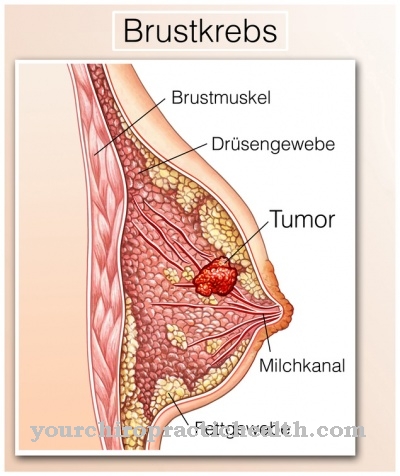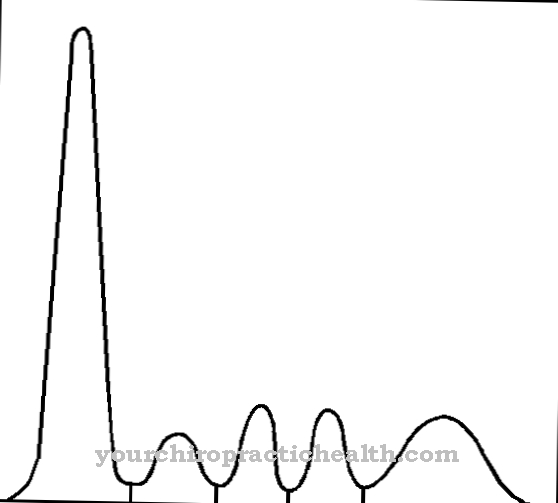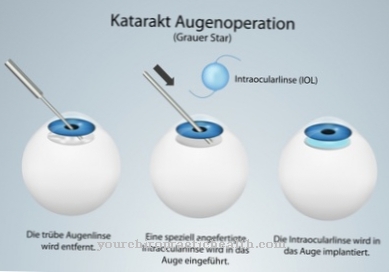Under the Refsum syndrome the physician understands a hereditary and episodic metabolic disorder. The symptoms affect the internal organs, the central nervous system, the peripheral nervous system and the skeleton, as well as the skin. The disease is largely brought to a standstill by a diet low in phytanic acid and plasmapheresis.
What is Refsum Syndrome?

© royaltystockphoto - stock.adobe.com
The Refsum syndrome or also the Refsum-Kahlke Disease is a so-called heredoataxia. The appearance is also called Refsum-Thiébaut disease, as Heredopathia atactica polyneuritiformis or Refsum's disease known. Heredoataxies are genetic diseases of the central nervous system. The main symptom of these diseases is ataxia, that is, disorders of the musculoskeletal system.
Refsum's syndrome is caused by a peroxisomal metabolic disorder. The peroxisomes are used in the body to break down metabolites. This breakdown is disturbed in Refsum's disease. Phytanic acid therefore accumulates and in particular has atactic consequences. The Norwegian Sigvald Refsum documented the disease for the first time in the 20th century and gave it its name. Refsum's syndrome is often referred to as hereditary and motor-sensitive neuropathy.
causes
The biochemical cause of Refsum's disease is the accumulation of phytanic acid. It is a saturated and branched-chain fatty acid that humans ingest with food. Peroxisomal α-oxidation is used to break down this fatty acid. This process is regulated by the enzyme phytanoyl-CoA-hydroxylase. A defect in this metabolic enzyme manifests itself as Refsum's syndrome. However, defects in the transport protein peroxin-7 can also be the cause of Refsum's disease.
The protein peroxin-7 is responsible for the transport of the phytanol-CoA-hydroxylase, which makes phytanic acid degradation possible. Refsum's disease is such a genetically heterogeneous disease. A failure of chromosome ten is usually related to a defect in the transport protein or the metabolic enzyme. The disease is passed on in an autosomal recessive manner. This means that both homologous chromosomes must carry the defect for it to break out.
Symptoms, ailments and signs
The sense of sight as well as the central nervous system, the skeletal system and the organ system can cause complaints in Refsum's disease. Night blindness is the most common early symptom. Most patients suffer from a progressive retina pigmentosa. That is, their retinal cells degenerate. This degeneration is associated with visual field deficits and later sometimes with blindness.
Uncontrolled eye movements and sudden clouding of the lens can also occur. The skin of the patient often suffers from cornification disorders. Some patients also lose their sense of smell, suffer from unsteady gait or lose their sense of their own spatial position. Tremors of intention and hearing loss sometimes accompany the symptoms mentioned.
Likewise typical symptoms of the metabolic disorder are failures of the tendon reflexes or damage to the peripheral nervous system. The skeletal system is sometimes affected by deformations, such as deformation of the toe or abnormally pronounced arches of the foot. Cardiac arrhythmias or bladder defects can also occur.
Diagnosis and course of disease
The doctor makes the diagnosis of Refsum's syndrome by detecting phytanic acid in the urine and plasma. The disease progresses in a relapsing manner. A relapse can be followed by a phase of relative symptomlessness. As a rule, the symptoms do not resolve completely. Only partial remissions are conceivable. Acute worsening of the disease occurs, for example, in the context of metabolic stress. Even with infections, in times of reduced calorie intake or during pregnancy, a noticeable deterioration can occur.
Complications
Various complications and long-term effects occur during Refsum's disease. The degeneration of the retinal cells is associated with visual field deficits, visual disturbances and, later, often also with complete blindness. Cornification disorders can occur in the skin area. Some patients suffer from unsteady gait and coordination disorders - both of which can cause accidents and falls.
Furthermore, it can lead to a loss of the sense of smell and hearing loss. As it progresses, the metabolic disorder causes damage to the peripheral nervous system and failure of the tendon reflexes. In severe cases, deformation of the skeletal system occurs. The person affected then suffers from abnormally pronounced arches of the foot or deformation of the toe.
Cardiac arrhythmias and bladder defects are also typical complications. The therapy of Refsum's syndrome harbors the risk of side effects and interactions from the medication administered. If the patient has to be treated via blood washing, this can be accompanied by infections, damage to the blood vessels and heart disease. Kidney damage cannot be ruled out either.
If the metabolic disorder is treated surgically, which is especially necessary in the case of malformations, it can lead to inflammation, bleeding, secondary bleeding and nerve injuries. Wound healing disorders or scars can develop after the operation.
When should you go to the doctor?
Refsum syndrome should always be treated by a doctor. This disease does not self-heal and, in most cases, the general condition of the person concerned worsens if treatment is not initiated. The means for self-help are also relatively limited.
A doctor should be consulted in Refsum syndrome if the person concerned suffers from various visual field defects. In the worst case scenario, this can lead to blindness. A hearing loss can also indicate the syndrome and should be examined by a doctor if it occurs over a long period of time and does not go away on its own. Since Refsum syndrome is also associated with heart problems, the person affected should have themselves checked regularly.
The diagnosis and treatment of Refsum's syndrome can be carried out by a general practitioner or an ophthalmologist. There are usually no particular complications.
Treatment and therapy
In an acute phase, Refsum syndrome is usually treated with plasmapheresis. A machine similar to a dialysis machine filters the pathological substances from the blood and then returns the patient's own blood. If there is currently no relapse, a low-phytanic acid diet is used to delay the relapse. In most cases, this diet largely brings the disease to a standstill. Humans ingest an average of 100 milligrams of phytanic acid per day.
As part of the diet, patients with Refsum's syndrome only consume around ten milligrams of phytanic acid per day. Dairy products and ruminant meat are usually deleted entirely because they contain the most phytanic acid. In order to block the mobilization from the adipose tissue, a balanced calorie intake is important. Often the special diet of the patient is combined with the administration of vitamins A, C and E. Normally, these measures allow skin changes to heal and neuropathies partially or completely recede.
The changes in the sense of sight and smell may not be reduced by the diet. On the other hand, they often do not progress further through the diet measures. The doctor regularly checks the phytanic acid concentration in the blood. If the concentration cannot be reduced by the measures mentioned, plasmapheresis may sometimes be indicated even in non-acute phases.
Refsum's syndrome is not curable so far, as there are no causal therapies available, only symptomatic therapies. Depending on the symptoms, the doctor may carry out additional therapy measures. In the case of skin changes, dermatological products, for example, can alleviate the symptoms.
prevention
Refsum's disease cannot be prevented so far. Either a person carries the genetic defect or he does not. Not every defect, however, has to result in an outbreak of disease. At least severe relapses can be prevented in Refsum's disease. For example, carriers of the defect should avoid metabolic stress.
Aftercare
Those affected with Refsum syndrome usually have very few and only very limited direct follow-up measures available, so that ideally a doctor should be consulted at an early stage and treatment should be initiated in this disease. Since this is a genetic disease, no independent healing can occur.
If you want to have children again, genetic testing and counseling should also be carried out in order to prevent Refsum syndrome from occurring again in the descendants. Refsum's syndrome is usually treated by means of physiotherapy or physiotherapy. Those affected can also repeat many of the exercises at home and thus accelerate the healing process.
Most of those affected by Refsum's syndrome are dependent on taking medication. All doctor's instructions should be followed. The prescribed dosage and regular intake must also be observed. In many cases, the life expectancy of the person affected is significantly reduced as a result of the disease.
You can do that yourself
In the case of Refsum syndrome, a consistent diet low in phytanic acid must first and foremost be followed. Affected people should not consume more than 10 milligrams of phytanic acid per day. This can be achieved by following a diet that is low in beef and dairy products and instead contains foods rich in vitamins and fiber. At the same time, care must be taken to ensure a sufficient intake of calories. This avoids uncontrolled mobilization of phytanic acid in the fat cells.
In addition, general measures such as sufficient exercise and the avoidance of stress apply. Affected people must pay attention to the physical warning signals. If unusual symptoms occur despite the diet, a visit to a doctor is recommended. Because Refsum syndrome is a metabolic disease, the best way to treat the disease is on a controlled diet. However, medication must always be taken. The doctor should be informed about any side effects of the prescribed preparations.
After a plasmapheresis, rest and bed rest apply. The replacement of the blood plasma is an enormous burden on the body and accordingly requires good aftercare. Patients with mild complaints can also use homeopathic remedies if necessary.





.jpg)


















.jpg)



